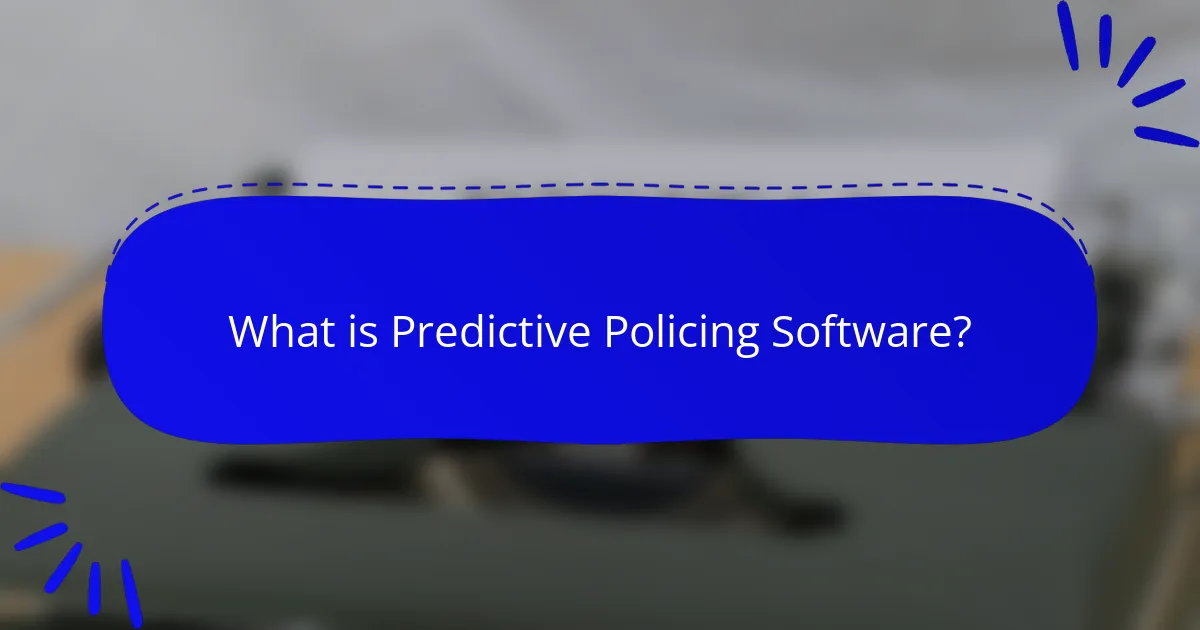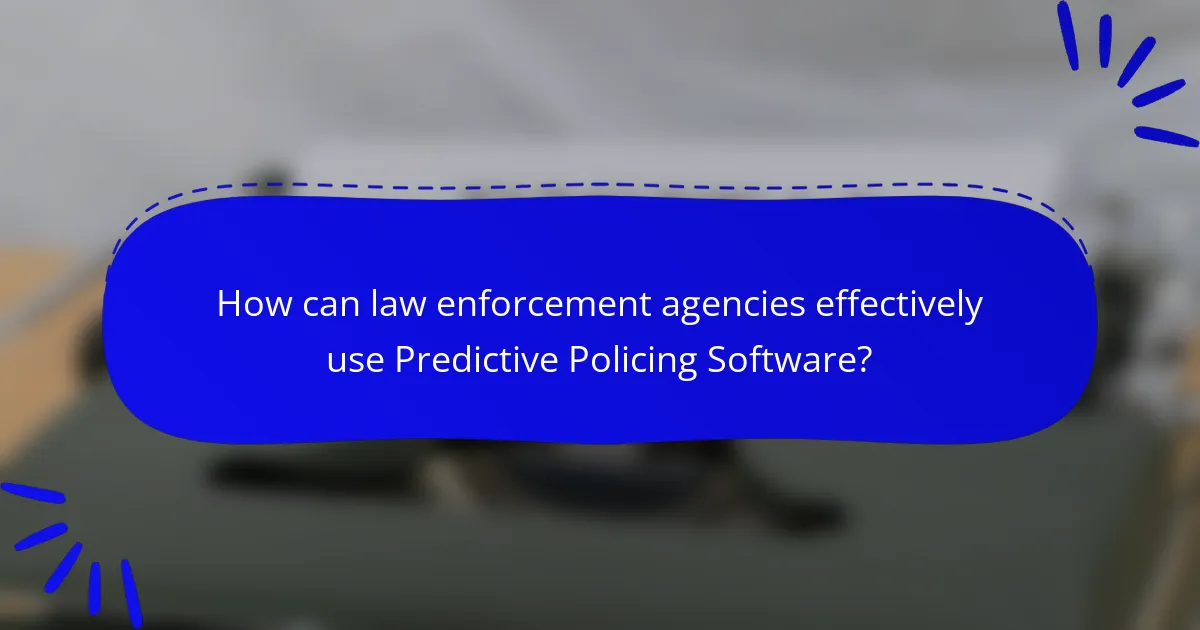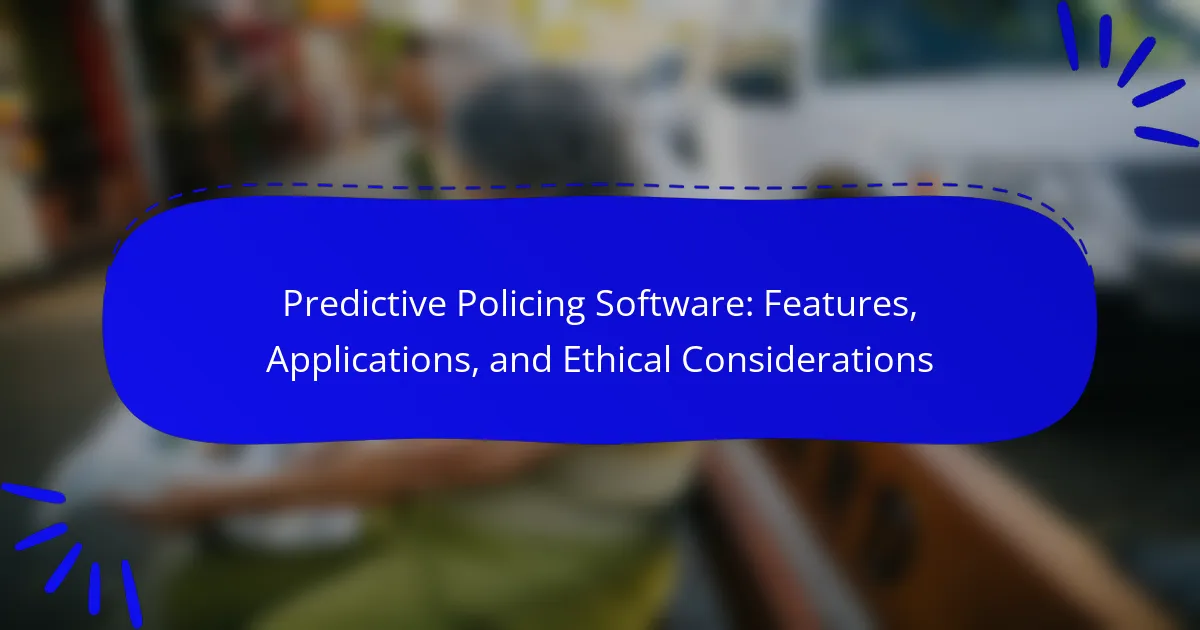
What is Predictive Policing Software?
Predictive policing software is a technology that uses data analysis to forecast potential criminal activity. It analyzes historical crime data, social media trends, and other relevant information. The goal is to identify patterns and predict where crimes are likely to occur. This software assists law enforcement agencies in resource allocation and crime prevention strategies. Studies have shown that predictive policing can lead to a reduction in crime rates by allowing proactive measures. For example, the Los Angeles Police Department implemented such software, resulting in a noticeable decrease in certain types of crime.
How does Predictive Policing Software function?
Predictive policing software analyzes historical crime data to forecast future criminal activity. It uses algorithms to identify patterns and trends in crime occurrences. The software processes data from various sources, including police reports, demographic information, and social media. It generates risk assessments for specific locations or individuals. Law enforcement agencies utilize these insights to allocate resources more effectively. Studies show that predictive policing can reduce crime rates by focusing on high-risk areas. However, it raises ethical concerns regarding bias and privacy.
What algorithms are utilized in Predictive Policing Software?
Predictive policing software utilizes algorithms such as regression analysis, machine learning, and neural networks. Regression analysis helps identify patterns in historical crime data. Machine learning algorithms can classify and predict criminal activity based on various input features. Neural networks process complex datasets to uncover hidden relationships between variables. Specific algorithms include Random Forest, Support Vector Machines, and Decision Trees. These algorithms analyze vast amounts of data to improve accuracy in crime prediction. Studies have shown that predictive policing can reduce crime rates by up to 20% when properly implemented.
How is data collected and processed in Predictive Policing Software?
Data in Predictive Policing Software is collected through various sources such as crime reports, social media, and public records. The software processes this data using algorithms to identify patterns and trends. It analyzes historical crime data to predict future incidents. Machine learning techniques enhance the accuracy of these predictions. Data is often visualized in maps or dashboards for law enforcement use. The effectiveness of this approach is supported by studies showing reduced crime rates in areas using predictive policing. For example, a study by the Manhattan Institute indicated a 10% reduction in crime in predictive policing areas.
What are the key features of Predictive Policing Software?
Predictive policing software utilizes algorithms to analyze data for crime forecasting. Key features include data integration from various sources, such as crime reports and social media. It employs machine learning techniques to identify patterns in criminal behavior. The software generates risk assessments for specific locations and times. Visualization tools present data in user-friendly formats. Real-time alerts notify law enforcement of potential incidents. The software also supports resource allocation by predicting where police presence is needed. Research indicates that predictive policing can enhance crime prevention strategies by 20% in some jurisdictions.
What types of analytics are included in Predictive Policing Software?
Predictive policing software includes several types of analytics. These analytics typically encompass crime trend analysis, risk terrain modeling, and social network analysis. Crime trend analysis identifies patterns and trends in criminal activity over time. Risk terrain modeling assesses the environmental factors that contribute to crime in specific locations. Social network analysis examines relationships between individuals and groups involved in criminal activity. Together, these analytics help law enforcement agencies allocate resources effectively and anticipate potential criminal events.
How does Predictive Policing Software integrate with existing law enforcement systems?
Predictive policing software integrates with existing law enforcement systems through data sharing and interoperability. It utilizes historical crime data, real-time data feeds, and geographic information systems. This integration allows law enforcement agencies to analyze patterns and trends in criminal activity. The software can connect with databases such as records management systems and computer-aided dispatch systems. This connectivity enhances situational awareness for officers on the ground. According to a 2019 report by the RAND Corporation, successful integration improves resource allocation and response times. The software also supports decision-making processes by providing actionable insights.
What are the applications of Predictive Policing Software?
Predictive policing software is used to forecast criminal activity and allocate police resources effectively. It analyzes historical crime data to identify patterns and hotspots. Law enforcement agencies apply this software for crime prevention and resource management. The software can also assist in identifying potential suspects based on behavioral patterns. Additionally, it helps in optimizing patrol routes and schedules. By using predictive analytics, police departments aim to reduce response times and improve public safety. Studies show that predictive policing can lead to a decrease in crime rates in targeted areas. For instance, the Los Angeles Police Department reported a 30% drop in property crimes after implementing such software.
In what scenarios is Predictive Policing Software most effective?
Predictive policing software is most effective in crime prevention and resource allocation scenarios. It analyzes historical crime data to identify patterns and hotspots. This enables law enforcement to deploy officers strategically. For example, cities using predictive analytics have reported a reduction in crime rates. A study by the University of California found that predictive policing can lead to a 20% decrease in property crimes. Furthermore, it aids in identifying potential repeat offenders. By focusing on areas with high crime likelihood, police can intervene before crimes occur. This proactive approach enhances public safety and optimizes police resources.
How do different law enforcement agencies implement Predictive Policing Software?
Different law enforcement agencies implement Predictive Policing Software by analyzing historical crime data. They utilize algorithms to identify patterns and predict future criminal activities. Agencies often collaborate with data scientists to customize software to their specific needs. Some departments integrate the software into their daily operations for real-time analysis. Training sessions for officers on how to interpret software outputs are common. The software varies in features, such as geographic mapping and risk assessment tools. Agencies also evaluate the effectiveness of the software through crime rate changes. Studies indicate that predictive policing can reduce crime in certain areas when used responsibly.

What ethical considerations surround Predictive Policing Software?
Predictive policing software raises significant ethical considerations. These include concerns about bias and discrimination. Algorithms may reinforce existing social biases in law enforcement. This can lead to disproportionate targeting of specific communities. Privacy issues also arise from data collection practices. Individuals may be monitored without their consent. Transparency in algorithmic decision-making is often lacking. This makes it difficult to understand how decisions are made. Accountability for wrongful arrests or profiling is another critical concern. The potential for misuse of data can undermine public trust in law enforcement.
How does bias affect Predictive Policing Software outcomes?
Bias negatively impacts Predictive Policing Software outcomes by skewing data analysis. This software relies on historical crime data to forecast future incidents. If the training data reflects existing biases, the software may over-police certain communities. For example, racial bias in arrest records can lead to disproportionate targeting of minority groups. Studies show that biased algorithms can result in higher false positive rates for these communities. The use of biased data perpetuates systemic inequalities in law enforcement practices. Consequently, biased outcomes can erode public trust in policing.
What measures can be taken to mitigate bias in Predictive Policing Software?
To mitigate bias in Predictive Policing Software, developers can implement several measures. First, they should ensure diverse training data. This helps to prevent the perpetuation of existing biases. Second, regular audits of algorithms are essential. These audits can identify and correct biased outcomes. Third, involving community stakeholders in the development process can provide valuable insights. This inclusion helps to address community-specific concerns. Fourth, transparency in algorithms and data sources is crucial. This allows for public scrutiny and accountability. Lastly, continuous training for law enforcement on bias awareness can enhance understanding. These measures collectively contribute to reducing bias in predictive policing systems.
Why is transparency important in the use of Predictive Policing Software?
Transparency is crucial in the use of predictive policing software to ensure accountability and trust. It allows stakeholders to understand how algorithms make decisions. This understanding can help prevent biases that may lead to unfair targeting of specific communities. Studies have shown that lack of transparency can result in public distrust and resistance to law enforcement practices. For example, the 2016 ACLU report highlighted concerns over biased data influencing policing outcomes. Ensuring transparency can also facilitate better oversight and regulatory compliance. This ultimately promotes ethical use of technology in law enforcement.
What are the privacy concerns related to Predictive Policing Software?
Predictive policing software raises significant privacy concerns. These systems often rely on vast amounts of data, including personal information. This data collection can infringe on individual privacy rights. Many citizens are unaware their data is being used for policing purposes. There is a risk of data breaches, exposing sensitive information. Predictive algorithms may also reinforce existing biases, leading to discriminatory practices. The lack of transparency in how these algorithms operate further exacerbates privacy issues. Studies have shown that communities of color are disproportionately affected by predictive policing. Overall, the use of such software requires careful consideration of privacy implications.
How does data privacy legislation impact Predictive Policing Software usage?
Data privacy legislation significantly restricts the usage of predictive policing software. These laws mandate the protection of personal data collected by law enforcement. Compliance with regulations, such as the General Data Protection Regulation (GDPR), requires transparency in data processing. Predictive policing software must ensure that data collection methods are lawful and justified. This often limits the types of data that can be used for analysis. Additionally, legislation may impose strict consent requirements for data sharing. Failure to adhere to these laws can result in legal repercussions for law enforcement agencies. Overall, data privacy legislation shapes the operational framework within which predictive policing software functions.
What are the implications of surveillance on community trust?
Surveillance can significantly undermine community trust. The presence of surveillance often leads to feelings of being watched, which can create anxiety among community members. This anxiety may result in a reluctance to participate in community activities or engage with law enforcement. Research indicates that communities with high surveillance report lower levels of trust in police and local authorities. For instance, a study by the Urban Institute found that increased surveillance correlates with decreased perceptions of safety and trust in community policing efforts. Additionally, marginalized communities may feel disproportionately targeted by surveillance, further eroding trust. Overall, the implications of surveillance on community trust are profound, leading to increased tension and decreased cooperation between residents and law enforcement.

How can law enforcement agencies effectively use Predictive Policing Software?
Law enforcement agencies can effectively use predictive policing software by analyzing historical crime data. This software identifies patterns and trends in criminal activity. By utilizing algorithms, agencies can forecast where crimes are likely to occur. This proactive approach allows for resource allocation to high-risk areas.
Studies, such as those conducted by the RAND Corporation, show that predictive policing can reduce crime rates by up to 30%. Additionally, agencies can enhance community engagement by sharing non-sensitive data insights with the public. This transparency fosters trust and collaboration.
Training personnel on software usage is crucial for maximizing effectiveness. Regular updates to the algorithms ensure accuracy in predictions. Overall, the strategic application of predictive policing software can lead to more informed decision-making in law enforcement.
What best practices should agencies follow when implementing Predictive Policing Software?
Agencies should follow several best practices when implementing Predictive Policing Software. First, they must ensure data quality and accuracy. High-quality data leads to better predictions. Second, agencies should prioritize transparency in their algorithms. Public trust is crucial for effective policing. Third, training personnel on the software is essential. Well-trained officers can interpret data correctly. Fourth, agencies should engage with community stakeholders. This fosters collaboration and addresses public concerns. Fifth, regular audits of the software are necessary. Audits help identify biases and improve fairness. Lastly, agencies must establish clear guidelines for data usage. This ensures compliance with legal and ethical standards. Implementing these best practices can enhance the effectiveness of Predictive Policing Software while maintaining public trust.
How can training improve the effectiveness of Predictive Policing Software?
Training enhances the effectiveness of predictive policing software by improving data analysis and algorithm accuracy. Well-trained personnel can better interpret data patterns and trends. This leads to more informed decision-making in law enforcement. Additionally, training ensures that users understand the software’s limitations. A study by the RAND Corporation found that effective training increases the accuracy of predictive models by up to 30%. Proper training also fosters collaboration between data scientists and law enforcement. This collaboration can refine algorithms based on real-world feedback. Enhanced training programs can lead to more ethical use of predictive policing tools as well.
What role does community engagement play in the successful use of Predictive Policing Software?
Community engagement is crucial for the successful use of predictive policing software. It fosters trust between law enforcement and the community. Trust enhances data sharing and cooperation. Engaged communities are more likely to provide valuable insights. This can lead to better-targeted interventions. Research shows that community input can improve the accuracy of predictive algorithms. For instance, a study by the Urban Institute found that community feedback significantly impacted policing strategies. Thus, effective community engagement directly correlates with the success of predictive policing initiatives.
What are common challenges faced when using Predictive Policing Software?
Common challenges faced when using predictive policing software include data bias, privacy concerns, and accuracy issues. Data bias occurs when the algorithms are trained on historical data that reflects existing prejudices. This can lead to discriminatory practices against certain communities. Privacy concerns arise from the collection and analysis of personal data without consent. Accuracy issues can result in false positives, misidentifying individuals as potential offenders based on flawed predictions. These challenges highlight the need for careful implementation and oversight of predictive policing technologies.
How can agencies address technical and operational challenges?
Agencies can address technical and operational challenges by implementing comprehensive training programs. These programs enhance staff proficiency with predictive policing software. Agencies should also invest in robust IT infrastructure to support software functionality. Regular updates and maintenance of the software are crucial for optimal performance. Collaboration with technology vendors can provide insights into best practices and troubleshooting. Furthermore, agencies must establish clear communication channels for feedback and support among users. Data privacy and ethical guidelines should be integrated into operational protocols. This ensures compliance and builds public trust in predictive policing initiatives.
What strategies can be employed to overcome public skepticism about Predictive Policing Software?
Engaging the public through transparency is essential to overcoming skepticism about Predictive Policing Software. Providing clear information about how the software works builds trust. Demonstrating the technology’s effectiveness with data can alleviate concerns. Sharing case studies where predictive policing has successfully reduced crime rates supports credibility. Involving community stakeholders in discussions fosters a sense of ownership. Addressing ethical concerns directly shows commitment to responsible use. Regularly updating the public on outcomes and adjustments to the software maintains ongoing dialogue. Collaborating with independent researchers to validate findings enhances objectivity and trust.
Predictive policing software is a technology that leverages data analysis to forecast potential criminal activity, aiding law enforcement in resource allocation and crime prevention strategies. The article explores its functionality, key features, and the algorithms utilized, such as regression analysis and machine learning, while also addressing the ethical considerations surrounding bias and privacy. Applications of this software include crime trend analysis and risk assessments, with studies indicating significant reductions in crime rates when implemented effectively. The challenges of data bias, privacy concerns, and the importance of community engagement and transparency in building trust are also examined, providing a comprehensive overview of the implications of predictive policing technology.
